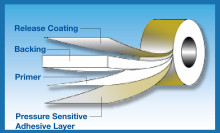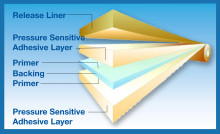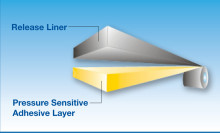Let's be honest about Pressure Sensitive Tape
So, we've talked in the past about water activated tape. We've talked about choosing the right tape. We even have a whole page on tesa tapes. But if you don't know all the tape information, how can you make the most informed decision. So, it's only fair to have a quick conversation about the type of tape that everyone is familiar with: Pressure Sensitive Adhesive.
- Adhesive - Typical adhesives are acrylic, natural rubber, or synthetic rubber. Special adhesives with a smaller application base are silicone, butyl, or EVA (ethylene - vinyl - acetate).
- Backings - A backing (often referred to as a carrier) is a relatively thin, flexible, webbased material. It can be made from various kinds of materials, such as paper, film, foil, foam, fabrics, non-wovens, and laminates. Backings are often chosen based on the application - such as cushioning, dampening, maintaining a barrier, etc.
- Primer - A primer is used to increase the holding power of the adhesive to the backing. The primer can be a liquid substance coated onto the backing material, or a physical treatment, such as corona or flame treatment. This is important if the tape needs to remove cleanly, or if the tape is stressed permanently with a load.
- Release Coating: The backing of a single-sided tape, and the release liner for a double-sided tape, are treated with a release coating. The release coating ensures stable unwinding of the tape during the application. This is very important for automatic applications in which the tape can be unwound at high speeds. A release coating can have different release forces for either easy unwinding or harder unwinding, depending on the customer’s needs.
- Adhesion: Adhesion is the attraction force between adhesive and substrate, which depends on the adhesive, the substrate, and the application conditions such as: application pressure, time period of pressure, and temperature during application.
- Cohesion: Cohesion describes the inner strength of an adhesive. It is relevant for applications where the force, in effect, is parallel to the bonding area. High cohesion goes hand-inhand with high temperature resistance, low-edge picking, and high holding power or shear resistance.
- Tack: Tack is the wetting capability of an adhesive to the substrate at first contact. Tack is effective under minimum pressure and for a short period of contact time. For most applications, tack is not relevant because time is required to press the tape to the substrate. For applications such as flying splices in the paper and print industry, tack is an important criterion. Tack also supports adhesion on rough surfaces. The thumb test is often used to characterize an adhesive, even though it gives no indication of the adhesion or the overall tape performance.
- Shear: Shear is the ability of an adhesive to resist creep or slippage.
- Tensile Strength: Tensile strength is mainly important for single-sidedtapes where the backing for the particular application has to withstand tensile stress. Carton sealing tapes or strapping/bundling applications are most important. The tensile strength of tape is usually not important for double-sided tapes, as long as the bonding materials are not stretchable.
Main types of adhesive tapes
How Pressure Sensitive Tape is Manufactured
Traditional Production Process
The ingredients – adhesive, resin, filler, and other additives are mixed with organic solvents or water.
The solved adhesive is transported to the coating device, after which the adhesive is coated in an even layer onto the backing and dried in the drying channel until all the solvents have evaporated. The result is a long roll of tape. After the coating process, the long rolls are converted into the desired roll sizes.
Hot-Melt Process





